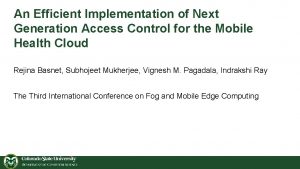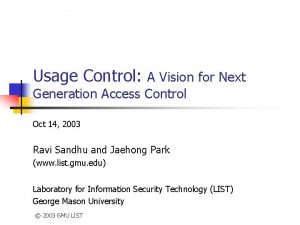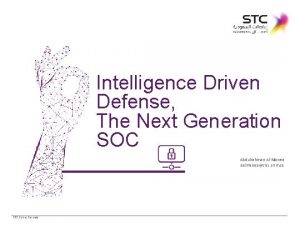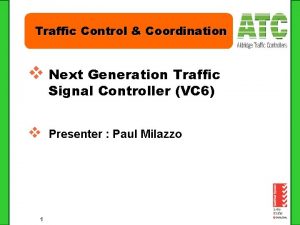Traffic Control Coordination v Next Generation Traffic Signal










- Slides: 10

Traffic Control & Coordination v Next Generation Traffic Signal Controller (VC 6) v 1 Presenter : Paul Milazzo

Traffic Control & Coordination v v Traffic Signal Controllers in Australia All Traffic Signal Controllers currently in production for the Australian market are manufactured to the Roads and Maritime Services Specification TSC/4 v v 2 All TSC/4 controllers are fully functional with SCATS All TSC/4 controllers currently run as VC 5 controllers

Traffic Control & Coordination v v Controller Software Overview SCATS and TRAFF Software developed by Roads and Maritime Services, NSW v TRAFF software integrated into the controller by manufacturers v TRAFF software interacts with manufacturer developed software sometimes referred to HRS v TRAFF software interacts with the controller personality (Site Specific Configuration Data) v Memory allocation increased in VC 6 for Personality Data 3

Traffic Control & Coordination System Overview SCATS Personality 4 TRAFF HRS

Traffic Control & Coordination Typical Controller Current controllers can have up to the following hardware configuration: 24 Signal Groups 16 Can be configured as Vehicle Groups, and 8 Can be configured as Pedestrian Groups 5 A TSC/4 Controller

Traffic Control & Coordination v The New Generation Controller can have up to 32 Signal Groups v These 32 Signal Groups can be ALL vehicle groups with no Pedestrian Groups or a mix as before with up to a maximum of 8 Pedestrian Groups v All signal groups have lamp monitoring capabilities (some older generation controllers only monitored the first 16 signal groups) v All signal groups have full conflict monitoring capabilities 6 Vic. Roads Theatrette - Kew

Traffic Control & Coordination Typical Controller Current controllers can have up to the following hardware configuration: 32 Inputs 24 Can be configured as Vehicle Detectors (e. g. loops), or TRAM Detectors, Emergency Vehicle Inputs 8 Can be configured as exclusively as Push Button Inputs 7 A TSC/4 Controller

Traffic Control & Coordination v The New Generation Controller can have up to 48 Inputs and 8 Push Button Inputs v This allows for addition detection features such as advance and departure detection as well as queue detection v The New Generation Controller can have up to 24 Special Purpose Inputs and 24 Special Purpose Outputs v These inputs and outputs can be used to controller ancillary devices v The New Generation Controller can have up to 32 XSF and MSS Flags, increased from 16 of each. v These flags can be used for features such as TRAM Priority. 8

Traffic Control & Coordination v Future Development 9 v Ability to maintain co-ordination through a short communications error v Increase reported operational data to SCATS for remote monitoring v v Implement Signal Phasing and Timing data (SPa. T) Increase number of phases

Traffic Control & Coordination v This is the end of this presentation. v 10 Thank you for your attention.
 X.next = x.next.next
X.next = x.next.next Next generation access control
Next generation access control Usage control model
Usage control model Which is the shape of a no passing zone sign?
Which is the shape of a no passing zone sign? Optical isomerism in octahedral complexes
Optical isomerism in octahedral complexes First gen antipsychotics
First gen antipsychotics Oh lord you are good and your mercy endureth forever
Oh lord you are good and your mercy endureth forever Palo alto traps gartner
Palo alto traps gartner Next generation wireless communication market
Next generation wireless communication market Nclex clinical judgement model
Nclex clinical judgement model Intelligence driven defense
Intelligence driven defense



















